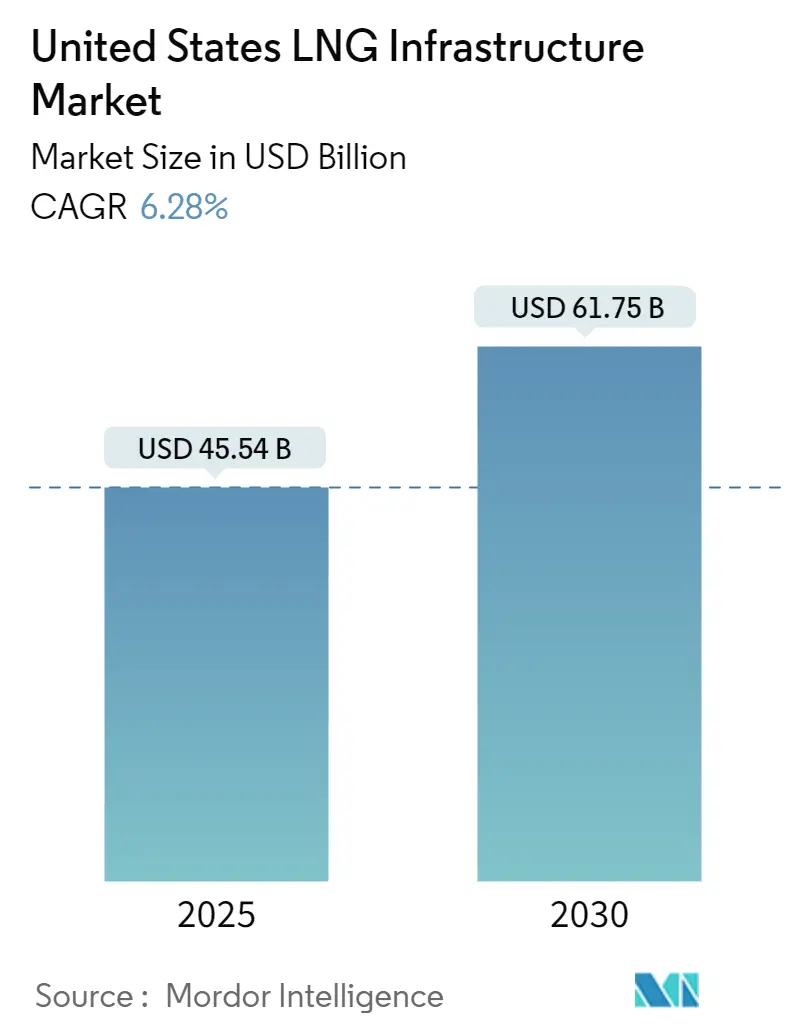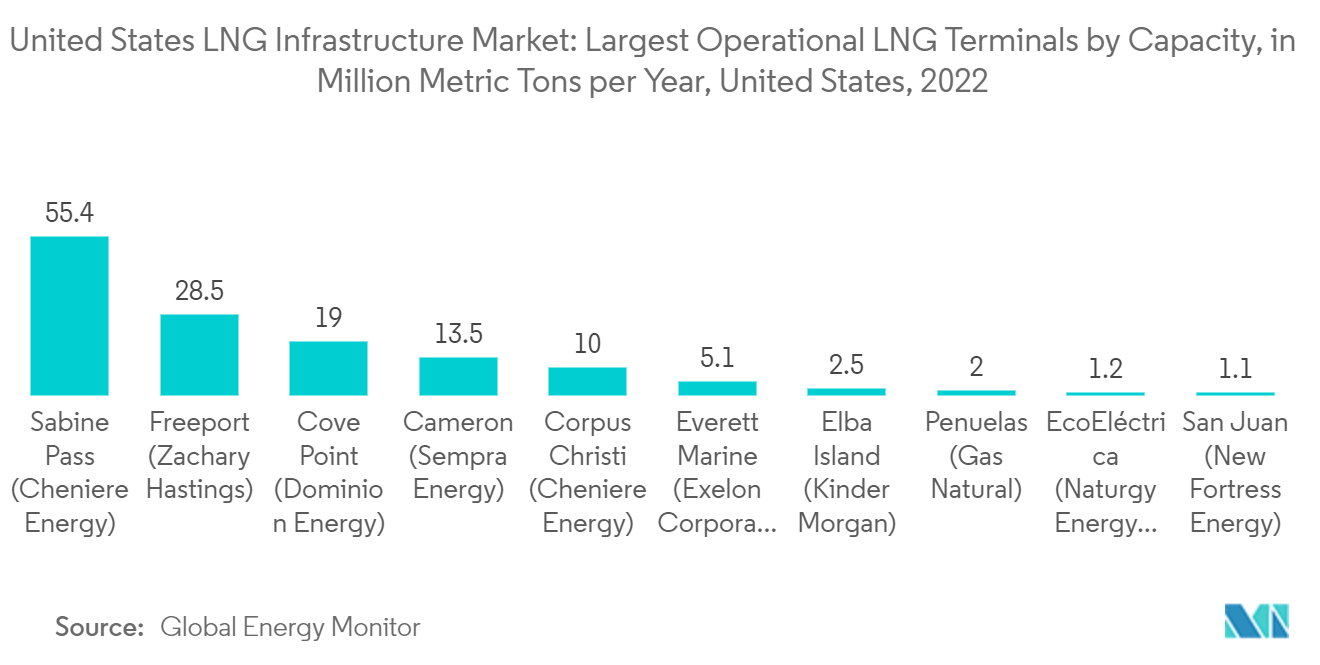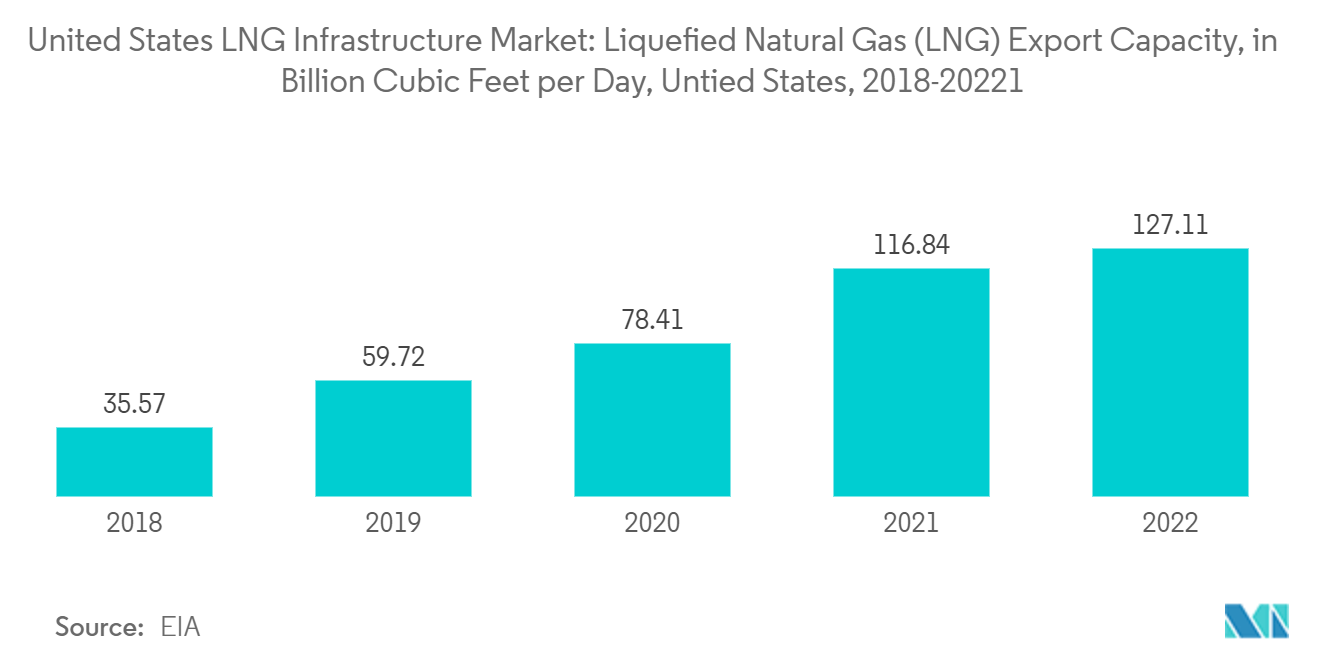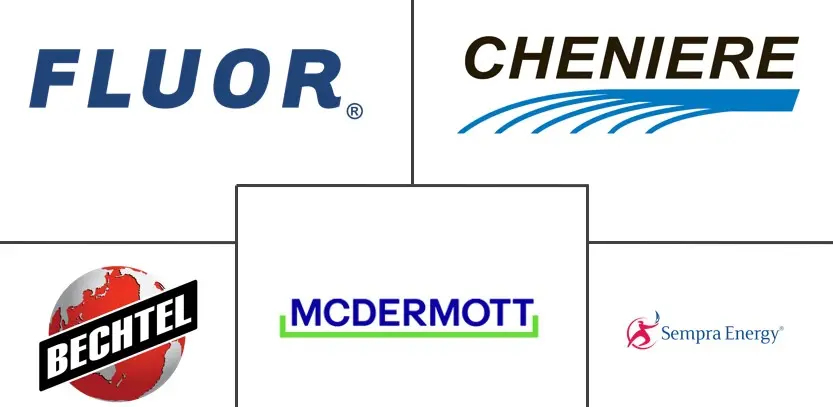
United States LNG Infrastructure Market Analysis by Mordor Intelligence
The United States LNG Infrastructure Market size is estimated at USD 45.54 billion in 2025, and is expected to reach USD 61.75 billion by 2030, at a CAGR of 6.28% during the forecast period (2025-2030).
- Over the medium term, factors such as the growing uses of natural gas in various sectors, such as power generation, to have lower carbon emissions for a cleaner environment are expected to drive the market during the forecast period. Moreover, the United States became a net LNG exporter in 2017, owing to an abundance of shale gas, which led to increased investments in export facilities, in turn promulgating the demand for LNG infrastructure in the country.
- On the other hand, volatile natural gas prices led to decreased exports, and a glut of LNG is expected to hinder market growth.
- Nevertheless, as per the Energy Information Administration (EIA), non-OECD Asian countries like China, India, Bangladesh, Thailand, and Vietnam are expected to consume 120 billion cubic feet per day (bcf/d) of natural gas by 2050, outpacing regional natural gas production by 50 bcf/d. Hence, the United States is expected to be a major exporter of natural gas to these countries, creating major opportunities for the market players.
United States LNG Infrastructure Market Trends and Insights
Liquefaction Plants Segment to Dominate the Market
- The United States accounted for over half of all new global liquefaction capacity added in 2021, is now the world's third-largest LNG seller, and is expected to become the biggest global LNG exporter in the latter part of the forecast period, overtaking Australia and Qatar.
- By the end of 2022, global liquefaction capacity reached 478.4 MTPA. New liquefaction capacity in the United States market accounted for 75% of the capacity increase in 2022. Sabine Pass LNG T6 (5.0 MTPA) and Calcasieu Pass LNG T1-T18 (10 MTPA) in the United States became operational in February and May 2022 respectively, giving the United States the largest operational liquefaction capacity worldwide in 2022 with total of 88.1 MTPA.
- The United States is one of the world's largest producers of natural gas. Natural gas supplies about one-third of the country's primary energy consumption, with its primary uses being heating and generating electricity. While the majority of natural gas is delivered in its gaseous form through the pipeline in the United States.
- The Sabine Pass terminal was the largest operational liquefied natural gas terminal in the United States as of 2022, with a capacity of 55.4 million metric tons per year. It is located in Louisiana and is the largest operational LNG terminal worldwide by capacity.
- Following Sabine Pass, the Freeport LNG terminal ranked second in the United States and seventh globally. This terminal is located in Texas and has a capacity of 28.5 million metric tons per annum. By 2026, Freeport will expand by 5.1 million metric tons, thus increasing its capacity by 5 million metric tons.
- In July 2022, The Fluor Corporation was awarded a full notice-to-proceed (FNTP) contract for the engineering, procurement, and fabrication management of the NFE Fast LNG 2 project by New Fortress Energy Inc. This project is a 1.4 million ton per annum LNG treatment and liquefaction plant that will be installed on fixed offshore platforms. It was planned to build the new LNG terminal in US federal waters, approximately 16 miles (26 kilometers) off the southeast coast of Grand Isle, Louisiana, using existing infrastructure.
- Therefore, with major exporting facilities and increasing liquefaction capacity plans in the country, the liquefaction plants segment is expected to be the largest market during the forecast period.

Increasing LNG Exports to Drive the Market
- Although most of the natural gas consumed in the United States is produced in the country, some natural gas is imported to help meet domestic demand. In addition to exporting natural gas, the United States imports and exports natural gas by pipeline as gas and by ship as liquefied natural gas (LNG). Trucks also transport LNG and compressed natural gas (CNG) in small quantities.
- According to the U.S. Energy Information Administration, the United States remained one of the largest exporter of LNG in 2022, exporting 127.11 billion cubic feet per day. According to IGU, the export capacity of liquefied natural gas was continuously increasing during the period under consideration. As the second-largest LNG exporter in the world, the U.S. ranks behind Australia.
- According to Internationa Gas Union (IGU), global LNG trade increased by 6.8% between 2021 and 2022 to about 401.5 million tonnes (MT). The pipeline gas supply shock following the onset of the Russia-Ukraine conflict led to a surge in LNG demand in Europe, where high prices pulled marginal cargoes away from Asia. The growth in exports from 2021 to 2022 was mainly driven by the United States (+10.5 MT, +15%), following the start-up of the Sabine Pass Train 6 and Calcasieu Pass projects.
- Therefore, supported by abundant supplies of shale gas and growing liquefaction capacity, the country's LNG export witnessed a significant rise, which started with the first commercial LNG cargo shipped from Cheniere's Sabine Pass in Louisiana in 2016 and is expected to increase during the forecast period.

Competitive Landscape
The United States LNG infrastructure market is fragmented. Some of the key players are (in no particular order) Chiyoda Corporation, Bechtel Corporation, McDermott International Inc., Sempra Energy, and Cheniere Energy Inc., among others.
United States LNG Infrastructure Industry Leaders
-
Chiyoda Corporation
-
Bechtel Corporation
-
McDermott International Inc
-
Sempra Energy
-
Cheniere Energy Inc
- *Disclaimer: Major Players sorted in no particular order

Recent Industry Developments
- February 2023: A mid-sized greenfield LNG export project launched by Gulfstream LNG Development was submitted to the Department of Energy (DOE) for approval to export up to 4 million metric tons of LNG per annum to free trade agreement (FTA) and non-FTA countries.
- April 2022: JGC Holdings Corporation, jointly with Zachry Industrial, Inc. (JZJV), was awarded a front-end engineering design (FEED) and engineering, procurement, and construction (EPC) bid agreement contract for the Cameron LNG expansion project located in Cameron Parish, Louisiana. Cameron LNG operates three natural gas liquefaction trains with an annual production of approximately 12 million tons. The expansion project focused on expanding production capacity by adding a fourth train (yearly output of approximately 6.75 million tons) to the existing trains utilizing electric drive (E-drive) motors.
United States LNG Infrastructure Market Report Scope
LNG infrastructure refers to the physical facilities and systems required to produce, transport, store, and distribute liquefied natural gas (LNG) from its source to end-users. LNG is natural gas that has been cooled to a temperature of -162°C (-260°F) to convert it into a liquid state, which makes it easier and more efficient to transport and store.
The United States LNG infrastructure is segmented into types. By type, the market is segmented into liquefaction plants and regasification plants. For each segment, market sizing and forecasts have been done based on revenue (USD).
| Liquefaction Plants |
| Regasification Plants |
| Type | Liquefaction Plants |
| Regasification Plants |
Key Questions Answered in the Report
How big is the United States LNG Infrastructure Market?
The United States LNG Infrastructure Market size is expected to reach USD 45.54 billion in 2025 and grow at a CAGR of 6.28% to reach USD 61.75 billion by 2030.
What is the current United States LNG Infrastructure Market size?
In 2025, the United States LNG Infrastructure Market size is expected to reach USD 45.54 billion.
Who are the key players in United States LNG Infrastructure Market?
Chiyoda Corporation, Bechtel Corporation, McDermott International Inc, Sempra Energy and Cheniere Energy Inc are the major companies operating in the United States LNG Infrastructure Market.
What years does this United States LNG Infrastructure Market cover, and what was the market size in 2024?
In 2024, the United States LNG Infrastructure Market size was estimated at USD 42.68 billion. The report covers the United States LNG Infrastructure Market historical market size for years: 2019, 2020, 2021, 2022, 2023 and 2024. The report also forecasts the United States LNG Infrastructure Market size for years: 2025, 2026, 2027, 2028, 2029 and 2030.
Page last updated on:
United States LNG Infrastructure Market Report
Statistics for the 2025 United States LNG Infrastructure market share, size and revenue growth rate, created by Mordor Intelligence™ Industry Reports. United States LNG Infrastructure analysis includes a market forecast outlook for 2025 to 2030 and historical overview. Get a sample of this industry analysis as a free report PDF download.



